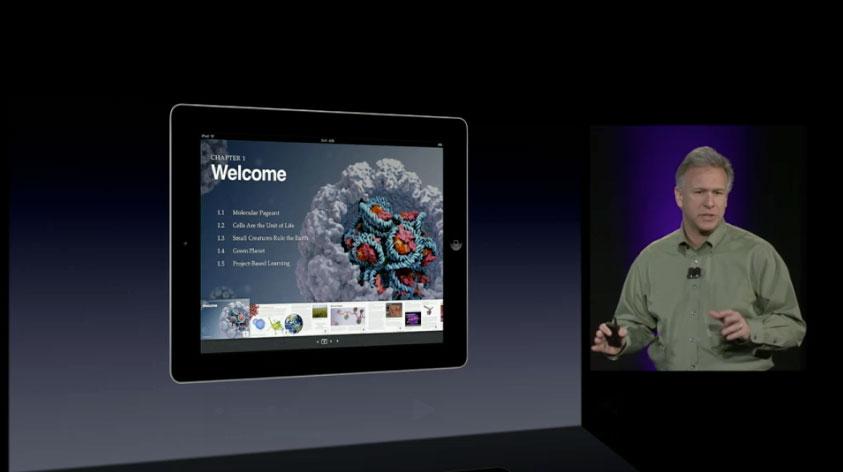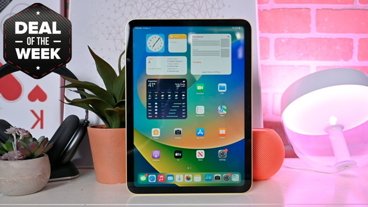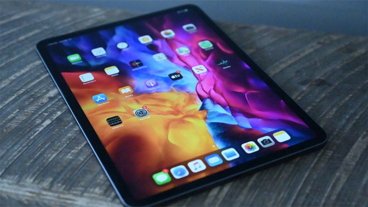The full video of the event can be seen at Apple's website. It requires Safari 4 or 5 on Mac OS X Snow Leopard or Lion, Safari on iOS 3 or later, or QuickTime 7 on Windows.
Thursday's event featured Phil Schiller, Apple's senior vice president for Worldwide Product Marketing, as well as Roger Rosner, vice president for Productivity Software. The keynote was held at New York City's Guggenheim Museum, and it clocked in at just under one hour.
The event was the official unveiling of iBooks 2 for iPad, which Apple has pitched as a new platform for textbooks in schools. The presentation included a live demonstration of new textbooks made for the iBooks 2 software.
Apple's textbook initiative already has the support of major publishers like McGraw Hill, Pearson and DK Publishing. The digital books are also much less expensive than their print counterparts, at prices of $14.99 or less.
Apple has also made it easier to create digital books for iOS with its new, free iBooks Author software for Mac OS X. With it, basic Microsoft Word files can even be automatically converted into an iBook file that can be sold on the iBookstore.
Also on Thursday, Apple unveiled the new iTunes U application for iPad. This free software allows college students to view course materials, receive updates from their teachers, and even sign up for classes.
Coinciding with those software releases, Apple also issued iTunes 10.5.3, which allows users of iBooks to to sync their textbook purchases with iTunes.
 AppleInsider Staff
AppleInsider Staff








 Christine McKee
Christine McKee
 Wesley Hilliard
Wesley Hilliard
 Malcolm Owen
Malcolm Owen
 Andrew Orr
Andrew Orr
 William Gallagher
William Gallagher
 Sponsored Content
Sponsored Content









44 Comments
If you look at the iPad at 42:39 into the video -- it shows a iPad held in portrait mode with a connector on the long side -- and there doesn't appear to be any home button.
School boards don't have any money.
Text Books are 1/32 the cost and last 32x longer then an iPad in the hands of kids would.
Schools can't afford art teachers or janitors anymore - so how are they going to pay for technical support on iPads? Are they going to purchase new iPads every 2 or 3 years when the batteries start to fail or the OS is no longer supported?
Then lets look at the environmental impact... paper is a renewable resource and biodegradable.
iPads, as cool as they are - are the scourge and a blight upon the earth. They are made of poisons and limited resources.
On the economic front - paper is made in America and the books are printed by Americans in America. This means jobs.
iPads are made in China by Chinese.
Anyways, it doesn't matter as this program is dead in the water... schools in California are shutting down buses, firing teachers and cramming classrooms... doubt they are going to throw money at iPads.
This program is complete garbage and a telling sign that Apple has lost touch with economic reality.
School boards don't have any money.
Text Books are 1/32 the cost and last 32x longer then an iPad in the hands of kids would.
Schools can't afford art teachers or janitors anymore - so how are they going to pay for technical support on iPads? Are they going to purchase new iPads every 2 or 3 years when the batteries start to fail or the OS is no longer supported?
Then lets look at the environmental impact... paper is a renewable resource and biodegradable.
iPads, as cool as they are - are the scourge and a blight upon the earth. They are made of poisons and limited resources.
On the economic front - paper is made in America and the books are printed by Americans in America. This means jobs.
iPads are made in China by Chinese.
Anyways, it doesn't matter as this program is dead in the water... schools in California are shutting down buses, firing teachers and cramming classrooms... doubt they are going to throw money at iPads.
This program is complete garbage and a telling sign that Apple has lost touch with economic reality.
I'm a little more optimistic.
If you look at the iPad at 42:39 into the video -- it shows a iPad held in portrait mode with a connector on the long side -- and there doesn't appear to be any home button.
& it looks a tad thicker too
I tried the app on my iPad 2 and it wasn't as fluid as in the videos. That could be the iPad 3.